Papers by Konstantin I Gurov
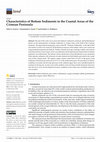
Land
The aim of this work was to assess the influence of physical, chemical, and hydrochemical factors... more The aim of this work was to assess the influence of physical, chemical, and hydrochemical factors on the characteristics of bottom sediments in various areas of the shelf of the Crimean Peninsula. The data obtained during the cruises of the RV “Professor Vodianitsky” in the fall of 2018 and summer of 2019 were analyzed. Hydrochemical analyses of the bottom waters were carried out using standard hydrochemical methods. Profiles of dissolved oxygen, hydrogen sulfide, and oxidized and reduced forms of iron in pore waters were obtained, and the geochemical characteristics of bottom sediments were determined. The features of their spatial and vertical distributions were considered. Pelite-aleuritic sediments with inclusions of sandy material and shell detritus prevailed in the coastal zone of the Crimean shelf. The organic carbon content varied from 0.5–0.6% in the gravel–sand sediments of the Kerch pre-strait area to 2.5–2.7% in the northwestern part. The prevalence of suboxic conditions...
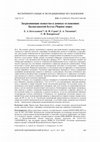
Morskoy gidrofizicheskiy zhurnal, 2019
The purpose of the paper consists in studying the pollution level, and the character of spatial d... more The purpose of the paper consists in studying the pollution level, and the character of spatial distribution of microelements and trace metals, the chlorophorm-extractable substances and petroleum hydrocarbons and in evaluating the features of their accumulation in the upper layer of bottom sediments in the Balaklava Bay depending on the natural and anthropogenic sources of pollutants. Methods and Results. The samples were taken from the bottom sediments upper layer (0-5 cm) in the Balaklava Bay by the Peterson grabber in February, 2015. Location of the sampling stations was chosen proceeding from the features of the bay morphometry, hydrological and hydrochemical water structure, pollution sources and the character of the sedimentation processes. The samples were selected, preprocessed and analyzed by the standard methods according to the regulatory documents. Some changes in relation between the clay fractions and the gravel material composition were revealed. The correlation dependence between the contents of chlorophorm-extractable substances and petroleum hydrocarbons was calculated. The features of spatial distribution of the metals' content depending on the natural geochemical processes in the bottom sediments are revealed. The regions subjected to the most intensive anthropogenic load within the region under study are distinguished. Conclusions. The content of clay material in all the samples taken in the Balaklava Bay on the average increased from 58.2 to 65.9 % and its maximum values are still concentrated in the western and northwestern parts of the water area under study. During last ten years, growth of the portion of a fine-grained material in the bottom fractions has been noted; at that the places where it accumulats are located in the areas of intense anthropogenic activity. The chlorophorm-extractable substances concentration in the Balaklava Bay bottom sediments varied within a wide range. On the whole, in course of the investigated period their content decreased, whereas the petroleum hydrocarbons concentration remained unchanged. It is found that pollution of the bottom sediments by metals is of a polyelemental nature and is characterized primarily by such metals as Pb, Cr, Zn, Cu and Sr. The increased microelements concentrations are observed in the northeastern and central parts of the water area, whereas the decreased metal concentrationsin its northwestern and eastern parts.
An precision of the chlorophyll-a concentration and the detrital matter absorption coefficient us... more An precision of the chlorophyll-a concentration and the detrital matter absorption coefficient using different algorithms for the Black Sea are obtained on the basis of numerical experiments in which varied the depth of the optically active layers and the its albedo. The numerical experiments compared with satellite observations performed in the deepwater part of the Black Sea in the first half of summer 2000 during the intensive coccolithophorids blooms are in good agreement.
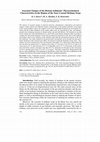
Physical Oceanography, Jul 1, 2018
The features of seasonal changes in physical (moisture, granulometric composition) and chemical (... more The features of seasonal changes in physical (moisture, granulometric composition) and chemical (organic carbon content and carbonate content) characteristics of the bottom sediments in the region of the coastal methane seeps in the southern sector of the Tarkhankut Peninsula are investigated. It is shown that the bottom sediments of the region under study are represented by fine-and mediumgrained sand containing inclusions of aleurite-pelitic silts and shell detritus. The obtained in situ data on the content and vertical distribution of Corg and CaCO3 in the bottom sediments make it possible to examine the intra-annual dynamics of the basic geochemical parameters in the areas of the methane gas hydrates and to assess influence of the methane seeps upon the geochemical structure of the bottom sediments. The values obtained for the period under investigation can be divided into three parts: before formation of the bacterial mass (May), the period of maximum formation of mat (June-September), the time of destruction of the mat structures (November). It is shown that in May before the mat structures are formed, the Corg content in the surface 0-2 cm layer is low (0.5 %), in June it increases up to 15.5 %, then decreases to 9.7 % in September and to 2.3 % in November. In the surface layer, the CaCO3 content is maximal in late May (93.5 %); during the mat formation in June it decreases to 16.6 % and then grows from 23.5 to 49.1 % in August-November, respectively. Being analyzed, the data on vertical distribution of the geochemical characteristics under study show that accumulations of the bacterial mats affect the intra-annual variation of the above-mentioned parameters.
Morskoy gidrofizicheskiy zhurnal

Physical Oceanography
Sediments on the Crimea southern coast shelf are studied within the Black Sea hygrophysical polyg... more Sediments on the Crimea southern coast shelf are studied within the Black Sea hygrophysical polygon in Katsiveli. Comparative analysis of the present sediments' parameters in the Crimea shelf zone is done. Physical and chemical characteristics of the bottom sediments (particle-size distribution, humidity, organic carbon content, carbonate content) are studied. The peculiarities of the sedimentation process and the specific features of spatial structure of the bottom sediment fractional composition and the organic matter content are revealed. According to the results of the study it was found that bottom sediments at the testing ground under research are represented generally by silty sands with pebbles and coquina and, to a lesser extent, by aleurite-pelitic silts. Coastal zone sediments are composed of medium sands with the inclusions of shell material and limestone gravel. Seaward part of the testing ground has the aleurite-pelitic silts. The analysis of distribution features of fine bottom sediment fractions and С org showed that a high content of organic carbon is characteristic of fine sediments, and it is evidenced by increased carbon concentrations in the seaward part of the water area. It is shown that the organic carbon content in the bottom sediments on the Crimea southern coast shelf does not exceed the background values. This fact indicates that the existing potential anthropogenic sources (of the Limensky Gulf) of organic carbon currently don't have a significant effect on its accumulation in bottom sediments. The areas of high carbonate concentrations coincide with the areas characterized by decreased content of fine fractions and organic carbon in the bottom sediments. Maximum values of carbonate content in Cape Kikineiz area are related to shell gravel accumulation.
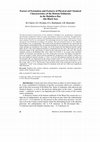
Physical Oceanography, 2015
The physicochemical characteristics of the sediments of Balaklava bay: granulometric composition ... more The physicochemical characteristics of the sediments of Balaklava bay: granulometric composition and fractional composition content of organic and inorganic carbon are considered. The spatial distribution of the main factions of particle size distribution and content of organic carbon (TOC) and calcium carbonate (CaCO 3) are investigated. The relationship between the organic and inorganic carbon and particle size distribution of sediments are analyzed. The main formation factors of the sediments from Balaklava bay are hightlighted. The results of the performed investigations have shown that the bottom deposits in the Balaklava Bay are represented mainly by silts and in some areas the gravel and sandy materials are interspersed. On average, for all the stations the fine-dispersed fraction content makes up 61%. The coarse-dispersed material is concentrated near the coast, and at the bay exit; the increased content of the sand fraction is typical for the central part of the water area. The calcium carbonate content in the Balaklava Bay varies within 18.32-82.95 %; its average value constitutes 40.06%. Its maximum concentrations are in the coastal parts of the bay. The highest correlation between the inorganic carbon content and the granulometric composition in the samples is observed in the coarse-dispersed material (fraction 2-1 mm). As for the fine-dispersed material, the sandy and alevrite-pelite silts are characterized by the inverse relation: from 0.4-for the fraction 0.25-0.1 mm up to 0.6 for the fraction lower than 0.05 mm. The organic carbon content varies from 0.66 to 4.74%; the average value is 2.37 %. The presence of the increased values in the central part of the bay can be explained by "weak" water exchange formed by minimum wind and wave effect and insignificant eddy formations.

Physical Oceanography, 2016
Assessment of state and quality of the sea and ocean surface layer waters resulted from binding t... more Assessment of state and quality of the sea and ocean surface layer waters resulted from binding the data from satellite images and the results of the simultaneously done in situ measurements is the actual direction of modern complex oceanological studies. Further development of this direction the immediate task of which consists in defining hydrochemical composition of water based on satellite data requires selecting the regions in the Black Sea where in situ measurements of water hydrochemical characteristics can be carried out simultaneously with satellite monitoring of the surface water state. The results of analysis of the hydrochemical characteristics' (main elements of nutrient and carbon cycles) spatial distribution in the Blue Bay waters based on the data of the expeditionary research carried out by Marine Hydrophysical Institute in 2002-2014 are represented. It is shown that this region and the stationary oceanographic platform (SOP) located in its southwestern part constitute a convenient ground for synchronous remote and sub-satellite studies of natural oceanological processes and impact of the coastal anthropogenic pollution sources. The data on hydrochemical characteristics of surface water in the SOP region can be used to study background state of the coastal marine environment as well as influence of intense natural processes (storms and (or) upwellings) upon formation and evolution of hydrochemical and optical structure of surface waters, surface water and atmosphere gas exchange, effect of physical, chemical and biological processes on the sea water quality. Influence of two coastal sources of anthropogenic pollution upon the Blue Bay marine environment was studied using synchronous remote and sub-satellite measurements; the results of these investigations provide additional opportunities for developing and certifying the methods of remote study and monitoring of the coastal marine environment state.
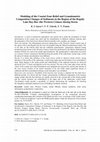
Physical Oceanography
A series of numerical experiments was carried out to study the mechanism of storm deformations of... more A series of numerical experiments was carried out to study the mechanism of storm deformations of the coastal zone relief and the redistribution of different sediment fractions after the parameters of the wind waves directed almost normally to the coastline, are changed. Data and methods. The lithodynamic processes taking place at the Western Crimea coastal zone in the region of the Lake Bogaily bay-bar were investigated using the XBeach mathematical model. The in-situ data on the bottom relief and the sediments granulometric composition obtained during monitoring observations in the Western Crimea coastal zone performed by the Marine Hydrophysical Institute of RAS was used as the model input parameters. The granulometric composition was preset as a mixture of three components distributed along the profile of the underwater coastal slope; at that the ratios of volume concentrations were different. Results. It is shown that influence of the storm waves results in intensive beach erosion, strong alteration of the profile of the underwater coastal slope upper part and formation of an accumulative body. Main changes of the initial profile and redistribution of the sediment fractions are observed during the first 3-6 hours and depend on the wave period. The rate of the water edge retreat and the values of the coastal zone relief deformation were quantitatively assessed for various time periods of the wave action. Position of the marine boundary of the site within which significant motion of sediments and their accumulation during a storm took place was calculated. Discussion and conclusion. Possibility of the bay-bar crest erosion is analyzed for the wind wave' different periods. It is shown that the volume concentrations of different components of the mixture change mainly after the fine fractions are rapidly removed to the seaward part of the bottom profile and the coarser fractions are redistributed in the upper part of the underwater coastal slope. The obtained results provide a possibility of indirect determining the conditions for blocking the alongshore sediments transport in case of building a hydraulic structure.

Physical Oceanography, 2021
Цель. На основе математического моделирования оценено влияние ветрового волнения на перераспредел... more Цель. На основе математического моделирования оценено влияние ветрового волнения на перераспределение песчаных фракций донных отложений полузамкнутой акватории эстуарного типа на примере Балаклавской бухты. Методы и результаты. Применялся двухмерный вариант морфодинамической модели XBeach с постоянным шагом сетки 10 м. Характеристики ветрового волнения на мористой границе расчетной области задавались с помощью спектра JONSWAP. Расчеты выполнялись для штормового волнения, возможного один раз в год. При проведении численных экспериментов использовались данные о гранулометрическом составе, полученные в ходе выполнения мониторинговых наблюдений в районе Балаклавской бухты. Выводы. Результаты моделирования подтвердили, что основными определяющими факторами, регулирующими перераспределение донного материала, являются глубина и уклон дна. Отмечено, что при резком изменении угла наклона дна между изобатами 6–7 и 7–8 м происходит осаждение крупных и средних фракций, а на участке между изобат...
Based on numerical experiments in which the influence of the depth of the optically active layer ... more Based on numerical experiments in which the influence of the depth of the optically active layer on the spectral properties of the water-leaving radiances was studied, estimates for the accuracy of the reconstructed diffuse attenuation index using the standard NASA technique were obtained.
Materials of XXVII International Coastal Conference "Arctic shores: shore-up to sustainability", 2019

The contamination level of sea bottom sediments with polycyclic aromatic hydrocarbons in the Bala... more The contamination level of sea bottom sediments with polycyclic aromatic hydrocarbons in the Balaklava Bay (the Black Sea) was estimated depending on sediments particle size distribution. The total content of these pollutants in the studied water area was averagely 2459,58 ng/g. The increased concentrations of polycyclic aromatic hydrocarbons are confined to the eastern coast and the central part of the bay. Fourteen polyaromatic hydrocarbons were totally identified in 2018, four of which (naphthalene, 2-methylnaphthalene, fluorene, anthracene) had a trace content. Four- and fivecyclic aromatic hydrocarbons made the main contribution to the pollution of sea bottom sediments. In particular, it was chrysene (40,1 %), fluoranthene (17,5 %), benz(b)fluoranthene (15,1 %). The concentration of benz(a)pyrene in bottom sediments of the Balaklava bay ranged from 0,05 - 121,0 ng/g. Its increased concentrations are confined to the central part of the bay in the eastern coast. The amount of pol...

The relevance of the study of the bottom sediments physicochemical characteristics in Crimea coas... more The relevance of the study of the bottom sediments physicochemical characteristics in Crimea coastal regions, known for their resort attractiveness, is explained by the fact that these characteristics largely determine or significantly affect on the characteristics of the pollutants and trace metals accumulation in them, the oxygen regime of pore and near-bottom waters and conditions for the occurrence of oxygen deficiency and secondary sources of pollution, environmental and recreational characteristics. The paper presents the results of a comprehensive physico-chemical analysis of the bottom sediments surface layer samples taken with the Ocean 0.1 dredger in the coastal zone of the Crimean Peninsula from Cape Tarkhankut to the Kerch Strait during the expedition on the R/V Professor Vodyanitsky in September 2018. A statistical assessment of the correlation between the individual fractions of bottom sediments, the content of organic matter and concentrations of trace metals was perf...

The aim of this work is to study the dynamics of bottom sediments granulometric fractions in the ... more The aim of this work is to study the dynamics of bottom sediments granulometric fractions in the Kalamitsky Gulf coastal zone near the Lake Sakskoe bay-bar under influence of storm surge based on the XBeach numerical morphodynamic model. A series of numerical experiments has been carried out, in which the parameters of waves at the seaward boundary of the computational domain changed in time, simulating the passage of a cyclonic atmospheric anomaly over the investigated region. The initial distribution of the sediment volume concentrations in different parts of the underwater coastal slope profile was set based on the results of field observations. The duration of model calculations was 24 h. The quantitative characteristics of the spatial distribution of various bottom sediments fractions, sediments median diameter and values of bottom deformations were obtained. It has been established that the main morphodynamic changes occurs in the area 0–120 m from the shoreline and are limite...

Physical Oceanography
Purpose. The aim of the work is to study spatial variability of the 137Cs and 40K concentrations ... more Purpose. The aim of the work is to study spatial variability of the 137Cs and 40K concentrations in the bottom sediments of the Balaklava Bay, and to estimate the sedimentation rate and relative content of the biogenic fraction. Methods and Results. The results of the 137Cs and 40K concentration measurements in 5 columns of the bottom sediments sampled in various parts of the Balaklava Bay are represented. Activity of 137Cs and 40K in the samples was determined by the gamma spectrometric analysis. Based on the measurement data, spatial variability of the 137Cs and 40K concentration fields in the bottom sediments was studied, and the sedimentation rate was quantitatively estimated. Application of the balance equation provided quantitative estimates of the relative biogenic fraction content; its spatial variability was described. Quantitative estimates of the relationship between the biogenic fraction estimates resulted from use of the direct and indirect methods are represented. Conc...

Ekologicheskaya bezopasnost' pribrezhnoy i shel'fovoy zon morya
The paper presents the results of studies of the Kalamitsky Bay bottom sediments pollution level ... more The paper presents the results of studies of the Kalamitsky Bay bottom sediments pollution level with microelements and heavy metals (Pb, Zn, Cu, Ni, Co, Cr, V, As, Sr, Ti, Fe, Mn) in comparison with the content of these microelements and heavy metals in the Balaklava Bay sediments. The paper analyzes data obtained during expeditions on the R/V Professor Vodyanitsky in the Kalamitsky Gulf in August 2011 (seaward part) and on the R/V Rioni in September 2012 (coastal area) as well as in the Balaklava Bay in October 2018. Content of microelements and heavy metals in bottom sediments of the studied water areas was determined by the X-ray fluorescence method using Spectroscan MAX-G device. For the water area of the Kalamitsky Gulf, the features of the studied trace element spatial distribution are considered, groups of trace elements with different spatial distribution patterns are identified. The correlation analysis determined influence of physicochemical characteristics of the sedimen...
Ekologicheskaya bezopasnost' pribrezhnoy i shel'fovoy zon morya
Ekologicheskaya bezopasnost pribrezhnoy i shel fovoy zon morya
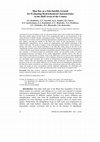
Results of analysis of hydrochemical characteristics (main elements of nutrient and carbon cycles... more Results of analysis of hydrochemical characteristics (main elements of nutrient and carbon cycles) spatial distribution in the Blue Bay waters based on the expeditionary research (carried out by Marine Hydrophysical Institute in 2002 – 2014) data are represented. It is shown that this area and the oceanographic platform located in its southwestern part constitute a convenient ground for synchronous remote and sub-satellite studies of natural oceanographic processes and impact of coastal anthropogenic sources of pollution. Introduction. The entire shelf part of the Black Sea (regardless of the fact which country an economic zone belongs to) is a water area exposed to constant and intensive anthropogenic impact. River runoff control, water exchange violation due to construction of different onshore facilities (e.g. piers), pollution and eutrophication, which arise from the insufficiently treated sewage waters and polluted river water discharge, are the factors of negative effect on co...

Uploads
Papers by Konstantin I Gurov